Creating Backend Services for Native Mobile Applications
By Steve Smith
Mobile apps can easily communicate with ASP.NET Core backend services.
View or download sample backend services code
The Sample Native Mobile App
This tutorial demonstrates how to create backend services using ASP.NET Core MVC to support native mobile apps. It uses the Xamarin Forms ToDoRest app as its native client, which includes separate native clients for Android, iOS, Windows Universal, and Window Phone devices. You can follow the linked tutorial to create the native app (and install the necessary free Xamarin tools), as well as download the Xamarin sample solution. The Xamarin sample includes an ASP.NET Web API 2 services project, which this article’s ASP.NET Core app replaces (with no changes required by the client).
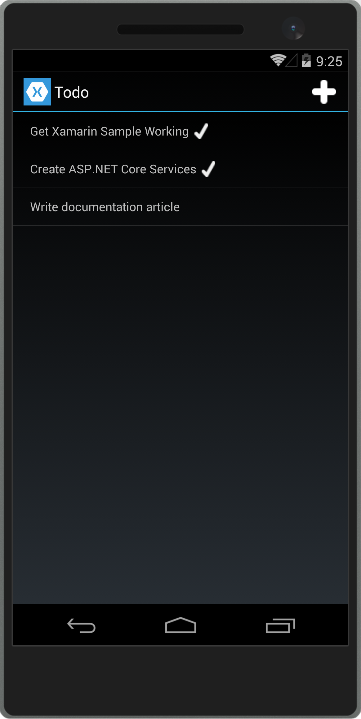
Features
The ToDoRest app supports listing, adding, deleting, and updating To-Do items. Each item has an ID, a Name, Notes, and a property indicating whether it’s been Done yet.
The main view of the items, as shown above, lists each item’s name and indicates if it is done with a checkmark.
Tapping the + icon opens an add item dialog:
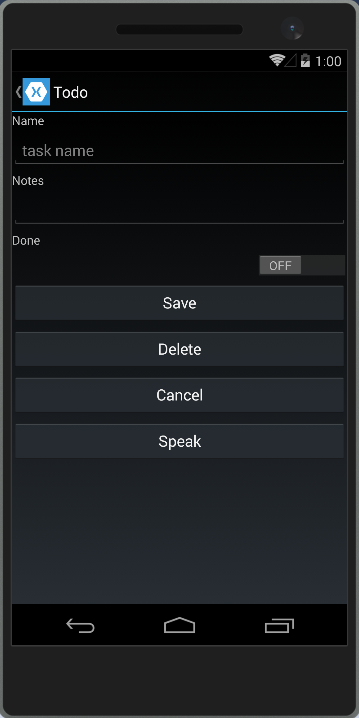
Tapping an item on the main list screen opens up an edit dialog where the item’s Name, Notes, and Done settings can be modified, or the item can be deleted:
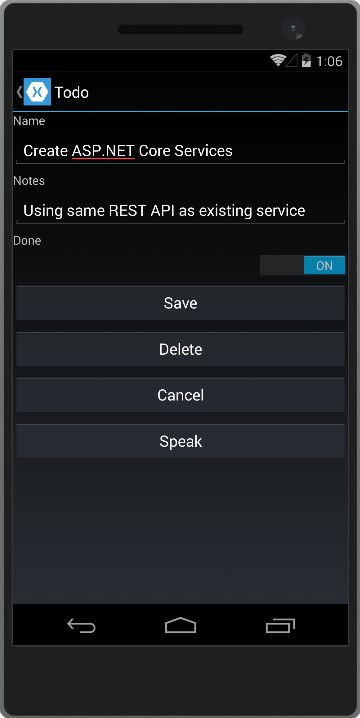
This sample is configured by default to use backend services hosted at developer.xamarin.com, which allow read-only operations. To test it out yourself against the ASP.NET Core app created in the next section running on your computer, you’ll need to update the app’s RestUrl constant. Navigate to the ToDoREST project and open the Constants.cs file. Replace the RestUrl with a URL that includes your machine’s IP address (not localhost or 127.0.0.1, since this address is used from the device emulator, not from your machine). Include the port number as well (5000). In order to test that your services work with a device, ensure you don’t have an active firewall blocking access to this port.
// URL of REST service (Xamarin ReadOnly Service)
//public static string RestUrl = "http://developer.xamarin.com:8081/api/todoitems{0}";
// use your machine's IP address
public static string RestUrl = "http://192.168.1.207:5000/api/todoitems/{0}";Creating the ASP.NET Core Project
Create a new ASP.NET Core Web Application in Visual Studio. Choose the Web API template and No Authentication. Name the project ToDoApi.
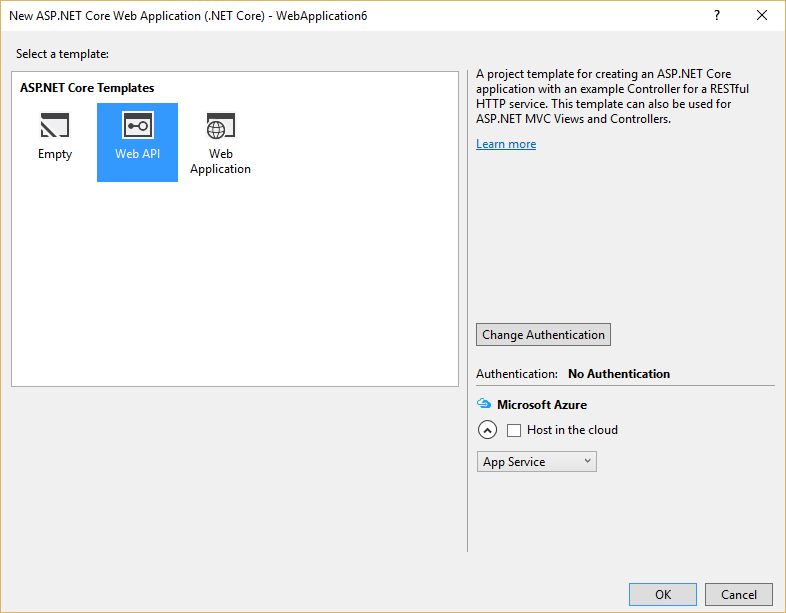
The application should respond to all requests made to port 5000. Update Program.cs to include .UseUrls("http://*:5000") to achieve this:
[!code-csharpMain]
1: using System.IO;
2: using Microsoft.AspNetCore.Hosting;
3:
4: namespace ToDoApi
5: {
6: public class Program
7: {
8: public static void Main(string[] args)
9: {
10: var host = new WebHostBuilder()
11: .UseKestrel()
12: .UseUrls("http://*:5000")
13: .UseContentRoot(Directory.GetCurrentDirectory())
14: .UseIISIntegration()
15: .UseStartup<Startup>()
16: .Build();
17:
18: host.Run();
19: }
20: }
21: }
[!NOTE] Make sure you run the application directly, rather than behind IIS Express, which ignores non-local requests by default. Run
dotnet runfrom a command prompt, or choose the application name profile from the Debug Target dropdown in the Visual Studio toolbar.
Add a model class to represent To-Do items. Mark required fields using the [Required] attribute:
[!code-csharpMain]
1: using System.ComponentModel.DataAnnotations;
2:
3: namespace ToDoApi.Models
4: {
5: public class ToDoItem
6: {
7: [Required]
8: public string ID { get; set; }
9:
10: [Required]
11: public string Name { get; set; }
12:
13: [Required]
14: public string Notes { get; set; }
15:
16: public bool Done { get; set; }
17: }
18: }
The API methods require some way to work with data. Use the same IToDoRepository interface the original Xamarin sample uses:
[!code-csharpMain]
1: using System.Collections.Generic;
2: using ToDoApi.Models;
3:
4: namespace ToDoApi.Interfaces
5: {
6: public interface IToDoRepository
7: {
8: bool DoesItemExist(string id);
9: IEnumerable<ToDoItem> All { get; }
10: ToDoItem Find(string id);
11: void Insert(ToDoItem item);
12: void Update(ToDoItem item);
13: void Delete(string id);
14: }
15: }
For this sample, the implementation just uses a private collection of items:
[!code-csharpMain]
1: using System.Collections.Generic;
2: using System.Linq;
3: using ToDoApi.Interfaces;
4: using ToDoApi.Models;
5:
6: namespace ToDoApi.Services
7: {
8: public class ToDoRepository : IToDoRepository
9: {
10: private List<ToDoItem> _toDoList;
11:
12: public ToDoRepository()
13: {
14: InitializeData();
15: }
16:
17: public IEnumerable<ToDoItem> All
18: {
19: get { return _toDoList; }
20: }
21:
22: public bool DoesItemExist(string id)
23: {
24: return _toDoList.Any(item => item.ID == id);
25: }
26:
27: public ToDoItem Find(string id)
28: {
29: return _toDoList.FirstOrDefault(item => item.ID == id);
30: }
31:
32: public void Insert(ToDoItem item)
33: {
34: _toDoList.Add(item);
35: }
36:
37: public void Update(ToDoItem item)
38: {
39: var todoItem = this.Find(item.ID);
40: var index = _toDoList.IndexOf(todoItem);
41: _toDoList.RemoveAt(index);
42: _toDoList.Insert(index, item);
43: }
44:
45: public void Delete(string id)
46: {
47: _toDoList.Remove(this.Find(id));
48: }
49:
50: private void InitializeData()
51: {
52: _toDoList = new List<ToDoItem>();
53:
54: var todoItem1 = new ToDoItem
55: {
56: ID = "6bb8a868-dba1-4f1a-93b7-24ebce87e243",
57: Name = "Learn app development",
58: Notes = "Attend Xamarin University",
59: Done = true
60: };
61:
62: var todoItem2 = new ToDoItem
63: {
64: ID = "b94afb54-a1cb-4313-8af3-b7511551b33b",
65: Name = "Develop apps",
66: Notes = "Use Xamarin Studio/Visual Studio",
67: Done = false
68: };
69:
70: var todoItem3 = new ToDoItem
71: {
72: ID = "ecfa6f80-3671-4911-aabe-63cc442c1ecf",
73: Name = "Publish apps",
74: Notes = "All app stores",
75: Done = false,
76: };
77:
78: _toDoList.Add(todoItem1);
79: _toDoList.Add(todoItem2);
80: _toDoList.Add(todoItem3);
81: }
82: }
83: }
Configure the implementation in Startup.cs:
[!code-csharpMain]
1: using System;
2: using System.Collections.Generic;
3: using System.Linq;
4: using Microsoft.AspNetCore.Builder;
5: using Microsoft.AspNetCore.Hosting;
6: using Microsoft.Extensions.Configuration;
7: using Microsoft.Extensions.DependencyInjection;
8: using Microsoft.Extensions.Logging;
9: using ToDoApi.Interfaces;
10: using ToDoApi.Services;
11:
12: namespace ToDoApi
13: {
14: public class Startup
15: {
16: public Startup(IHostingEnvironment env)
17: {
18: var builder = new ConfigurationBuilder()
19: .SetBasePath(env.ContentRootPath)
20: .AddJsonFile("appsettings.json", optional: true, reloadOnChange: true)
21: .AddJsonFile($"appsettings.{env.EnvironmentName}.json", optional: true)
22: .AddEnvironmentVariables();
23: Configuration = builder.Build();
24: }
25:
26: public IConfigurationRoot Configuration { get; }
27:
28: // This method gets called by the runtime. Use this method to add services to the container.
29: public void ConfigureServices(IServiceCollection services)
30: {
31: // Add framework services.
32: services.AddMvc();
33:
34: services.AddSingleton<IToDoRepository,ToDoRepository>();
35: }
36:
37: // This method gets called by the runtime. Use this method to configure the HTTP request pipeline.
38: public void Configure(IApplicationBuilder app, IHostingEnvironment env, ILoggerFactory loggerFactory)
39: {
40: loggerFactory.AddConsole(Configuration.GetSection("Logging"));
41: loggerFactory.AddDebug();
42:
43: app.UseMvc();
44: }
45: }
46: }
At this point, you’re ready to create the ToDoItemsController.
[!TIP] Learn more about creating web APIs in Building Your First Web API with ASP.NET Core MVC and Visual Studio.
Creating the Controller
Add a new controller to the project, ToDoItemsController. It should inherit from Microsoft.AspNetCore.Mvc.Controller. Add a Route attribute to indicate that the controller will handle requests made to paths starting with api/todoitems. The [controller] token in the route is replaced by the name of the controller (omitting the Controller suffix), and is especially helpful for global routes. Learn more about routing.
The controller requires an IToDoRepository to function; request an instance of this type through the controller’s constructor. At runtime, this instance will be provided using the framework’s support for dependency injection.
[!code-csharpMain]
1: using System;
2: using Microsoft.AspNetCore.Http;
3: using Microsoft.AspNetCore.Mvc;
4: using ToDoApi.Interfaces;
5: using ToDoApi.Models;
6:
7: namespace ToDoApi.Controllers
8: {
9: [Route("api/[controller]")]
10: public class ToDoItemsController : Controller
11: {
12: private readonly IToDoRepository _toDoRepository;
13:
14: public ToDoItemsController(IToDoRepository toDoRepository)
15: {
16: _toDoRepository = toDoRepository;
17: }
18:
19: [HttpGet]
20: public IActionResult List()
21: {
22: return Ok(_toDoRepository.All);
23: }
24:
25: [HttpPost]
26: public IActionResult Create([FromBody] ToDoItem item)
27: {
28: try
29: {
30: if (item == null || !ModelState.IsValid)
31: {
32: return BadRequest(ErrorCode.TodoItemNameAndNotesRequired.ToString());
33: }
34: bool itemExists = _toDoRepository.DoesItemExist(item.ID);
35: if (itemExists)
36: {
37: return StatusCode(StatusCodes.Status409Conflict, ErrorCode.TodoItemIDInUse.ToString());
38: }
39: _toDoRepository.Insert(item);
40: }
41: catch (Exception)
42: {
43: return BadRequest(ErrorCode.CouldNotCreateItem.ToString());
44: }
45: return Ok(item);
46: }
47:
48: [HttpPut]
49: public IActionResult Edit([FromBody] ToDoItem item)
50: {
51: try
52: {
53: if (item == null || !ModelState.IsValid)
54: {
55: return BadRequest(ErrorCode.TodoItemNameAndNotesRequired.ToString());
56: }
57: var existingItem = _toDoRepository.Find(item.ID);
58: if (existingItem == null)
59: {
60: return NotFound(ErrorCode.RecordNotFound.ToString());
61: }
62: _toDoRepository.Update(item);
63: }
64: catch (Exception)
65: {
66: return BadRequest(ErrorCode.CouldNotUpdateItem.ToString());
67: }
68: return NoContent();
69: }
70:
71: [HttpDelete("{id}")]
72: public IActionResult Delete(string id)
73: {
74: try
75: {
76: var item = _toDoRepository.Find(id);
77: if (item == null)
78: {
79: return NotFound(ErrorCode.RecordNotFound.ToString());
80: }
81: _toDoRepository.Delete(id);
82: }
83: catch (Exception)
84: {
85: return BadRequest(ErrorCode.CouldNotDeleteItem.ToString());
86: }
87: return NoContent();
88: }
89: }
90:
91: public enum ErrorCode
92: {
93: TodoItemNameAndNotesRequired,
94: TodoItemIDInUse,
95: RecordNotFound,
96: CouldNotCreateItem,
97: CouldNotUpdateItem,
98: CouldNotDeleteItem
99: }
100:
101: }
This API supports four different HTTP verbs to perform CRUD (Create, Read, Update, Delete) operations on the data source. The simplest of these is the Read operation, which corresponds to an HTTP GET request.
Reading Items
Requesting a list of items is done with a GET request to the List method. The [HttpGet] attribute on the List method indicates that this action should only handle GET requests. The route for this action is the route specified on the controller. You don’t necessarily need to use the action name as part of the route. You just need to ensure each action has a unique and unambiguous route. Routing attributes can be applied at both the controller and method levels to build up specific routes.
[!code-csharpMain]
1: using System;
2: using Microsoft.AspNetCore.Http;
3: using Microsoft.AspNetCore.Mvc;
4: using ToDoApi.Interfaces;
5: using ToDoApi.Models;
6:
7: namespace ToDoApi.Controllers
8: {
9: [Route("api/[controller]")]
10: public class ToDoItemsController : Controller
11: {
12: private readonly IToDoRepository _toDoRepository;
13:
14: public ToDoItemsController(IToDoRepository toDoRepository)
15: {
16: _toDoRepository = toDoRepository;
17: }
18:
19: [HttpGet]
20: public IActionResult List()
21: {
22: return Ok(_toDoRepository.All);
23: }
24:
25: [HttpPost]
26: public IActionResult Create([FromBody] ToDoItem item)
27: {
28: try
29: {
30: if (item == null || !ModelState.IsValid)
31: {
32: return BadRequest(ErrorCode.TodoItemNameAndNotesRequired.ToString());
33: }
34: bool itemExists = _toDoRepository.DoesItemExist(item.ID);
35: if (itemExists)
36: {
37: return StatusCode(StatusCodes.Status409Conflict, ErrorCode.TodoItemIDInUse.ToString());
38: }
39: _toDoRepository.Insert(item);
40: }
41: catch (Exception)
42: {
43: return BadRequest(ErrorCode.CouldNotCreateItem.ToString());
44: }
45: return Ok(item);
46: }
47:
48: [HttpPut]
49: public IActionResult Edit([FromBody] ToDoItem item)
50: {
51: try
52: {
53: if (item == null || !ModelState.IsValid)
54: {
55: return BadRequest(ErrorCode.TodoItemNameAndNotesRequired.ToString());
56: }
57: var existingItem = _toDoRepository.Find(item.ID);
58: if (existingItem == null)
59: {
60: return NotFound(ErrorCode.RecordNotFound.ToString());
61: }
62: _toDoRepository.Update(item);
63: }
64: catch (Exception)
65: {
66: return BadRequest(ErrorCode.CouldNotUpdateItem.ToString());
67: }
68: return NoContent();
69: }
70:
71: [HttpDelete("{id}")]
72: public IActionResult Delete(string id)
73: {
74: try
75: {
76: var item = _toDoRepository.Find(id);
77: if (item == null)
78: {
79: return NotFound(ErrorCode.RecordNotFound.ToString());
80: }
81: _toDoRepository.Delete(id);
82: }
83: catch (Exception)
84: {
85: return BadRequest(ErrorCode.CouldNotDeleteItem.ToString());
86: }
87: return NoContent();
88: }
89: }
90:
91: public enum ErrorCode
92: {
93: TodoItemNameAndNotesRequired,
94: TodoItemIDInUse,
95: RecordNotFound,
96: CouldNotCreateItem,
97: CouldNotUpdateItem,
98: CouldNotDeleteItem
99: }
100:
101: }
The List method returns a 200 OK response code and all of the ToDo items, serialized as JSON.
You can test your new API method using a variety of tools, such as Postman, shown here:
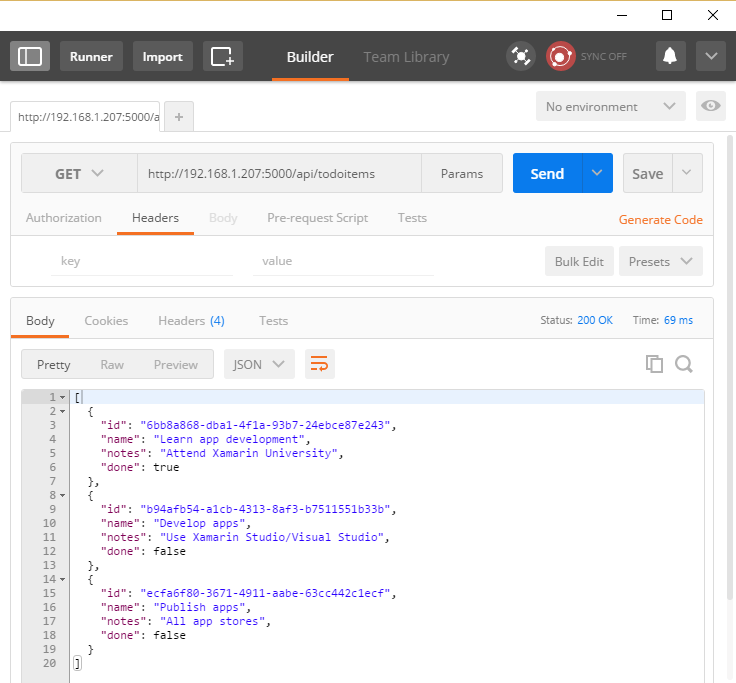
Creating Items
By convention, creating new data items is mapped to the HTTP POST verb. The Create method has an [HttpPost] attribute applied to it, and accepts a ToDoItem instance. Since the item argument will be passed in the body of the POST, this parameter is decorated with the [FromBody] attribute.
Inside the method, the item is checked for validity and prior existence in the data store, and if no issues occur, it is added using the repository. Checking ModelState.IsValid performs model validation, and should be done in every API method that accepts user input.
[!code-csharpMain]
1: using System;
2: using Microsoft.AspNetCore.Http;
3: using Microsoft.AspNetCore.Mvc;
4: using ToDoApi.Interfaces;
5: using ToDoApi.Models;
6:
7: namespace ToDoApi.Controllers
8: {
9: [Route("api/[controller]")]
10: public class ToDoItemsController : Controller
11: {
12: private readonly IToDoRepository _toDoRepository;
13:
14: public ToDoItemsController(IToDoRepository toDoRepository)
15: {
16: _toDoRepository = toDoRepository;
17: }
18:
19: [HttpGet]
20: public IActionResult List()
21: {
22: return Ok(_toDoRepository.All);
23: }
24:
25: [HttpPost]
26: public IActionResult Create([FromBody] ToDoItem item)
27: {
28: try
29: {
30: if (item == null || !ModelState.IsValid)
31: {
32: return BadRequest(ErrorCode.TodoItemNameAndNotesRequired.ToString());
33: }
34: bool itemExists = _toDoRepository.DoesItemExist(item.ID);
35: if (itemExists)
36: {
37: return StatusCode(StatusCodes.Status409Conflict, ErrorCode.TodoItemIDInUse.ToString());
38: }
39: _toDoRepository.Insert(item);
40: }
41: catch (Exception)
42: {
43: return BadRequest(ErrorCode.CouldNotCreateItem.ToString());
44: }
45: return Ok(item);
46: }
47:
48: [HttpPut]
49: public IActionResult Edit([FromBody] ToDoItem item)
50: {
51: try
52: {
53: if (item == null || !ModelState.IsValid)
54: {
55: return BadRequest(ErrorCode.TodoItemNameAndNotesRequired.ToString());
56: }
57: var existingItem = _toDoRepository.Find(item.ID);
58: if (existingItem == null)
59: {
60: return NotFound(ErrorCode.RecordNotFound.ToString());
61: }
62: _toDoRepository.Update(item);
63: }
64: catch (Exception)
65: {
66: return BadRequest(ErrorCode.CouldNotUpdateItem.ToString());
67: }
68: return NoContent();
69: }
70:
71: [HttpDelete("{id}")]
72: public IActionResult Delete(string id)
73: {
74: try
75: {
76: var item = _toDoRepository.Find(id);
77: if (item == null)
78: {
79: return NotFound(ErrorCode.RecordNotFound.ToString());
80: }
81: _toDoRepository.Delete(id);
82: }
83: catch (Exception)
84: {
85: return BadRequest(ErrorCode.CouldNotDeleteItem.ToString());
86: }
87: return NoContent();
88: }
89: }
90:
91: public enum ErrorCode
92: {
93: TodoItemNameAndNotesRequired,
94: TodoItemIDInUse,
95: RecordNotFound,
96: CouldNotCreateItem,
97: CouldNotUpdateItem,
98: CouldNotDeleteItem
99: }
100:
101: }
The sample uses an enum containing error codes that are passed to the mobile client:
[!code-csharpMain]
1: using System;
2: using Microsoft.AspNetCore.Http;
3: using Microsoft.AspNetCore.Mvc;
4: using ToDoApi.Interfaces;
5: using ToDoApi.Models;
6:
7: namespace ToDoApi.Controllers
8: {
9: [Route("api/[controller]")]
10: public class ToDoItemsController : Controller
11: {
12: private readonly IToDoRepository _toDoRepository;
13:
14: public ToDoItemsController(IToDoRepository toDoRepository)
15: {
16: _toDoRepository = toDoRepository;
17: }
18:
19: [HttpGet]
20: public IActionResult List()
21: {
22: return Ok(_toDoRepository.All);
23: }
24:
25: [HttpPost]
26: public IActionResult Create([FromBody] ToDoItem item)
27: {
28: try
29: {
30: if (item == null || !ModelState.IsValid)
31: {
32: return BadRequest(ErrorCode.TodoItemNameAndNotesRequired.ToString());
33: }
34: bool itemExists = _toDoRepository.DoesItemExist(item.ID);
35: if (itemExists)
36: {
37: return StatusCode(StatusCodes.Status409Conflict, ErrorCode.TodoItemIDInUse.ToString());
38: }
39: _toDoRepository.Insert(item);
40: }
41: catch (Exception)
42: {
43: return BadRequest(ErrorCode.CouldNotCreateItem.ToString());
44: }
45: return Ok(item);
46: }
47:
48: [HttpPut]
49: public IActionResult Edit([FromBody] ToDoItem item)
50: {
51: try
52: {
53: if (item == null || !ModelState.IsValid)
54: {
55: return BadRequest(ErrorCode.TodoItemNameAndNotesRequired.ToString());
56: }
57: var existingItem = _toDoRepository.Find(item.ID);
58: if (existingItem == null)
59: {
60: return NotFound(ErrorCode.RecordNotFound.ToString());
61: }
62: _toDoRepository.Update(item);
63: }
64: catch (Exception)
65: {
66: return BadRequest(ErrorCode.CouldNotUpdateItem.ToString());
67: }
68: return NoContent();
69: }
70:
71: [HttpDelete("{id}")]
72: public IActionResult Delete(string id)
73: {
74: try
75: {
76: var item = _toDoRepository.Find(id);
77: if (item == null)
78: {
79: return NotFound(ErrorCode.RecordNotFound.ToString());
80: }
81: _toDoRepository.Delete(id);
82: }
83: catch (Exception)
84: {
85: return BadRequest(ErrorCode.CouldNotDeleteItem.ToString());
86: }
87: return NoContent();
88: }
89: }
90:
91: public enum ErrorCode
92: {
93: TodoItemNameAndNotesRequired,
94: TodoItemIDInUse,
95: RecordNotFound,
96: CouldNotCreateItem,
97: CouldNotUpdateItem,
98: CouldNotDeleteItem
99: }
100:
101: }
Test adding new items using Postman by choosing the POST verb providing the new object in JSON format in the Body of the request. You should also add a request header specifying a Content-Type of application/json.
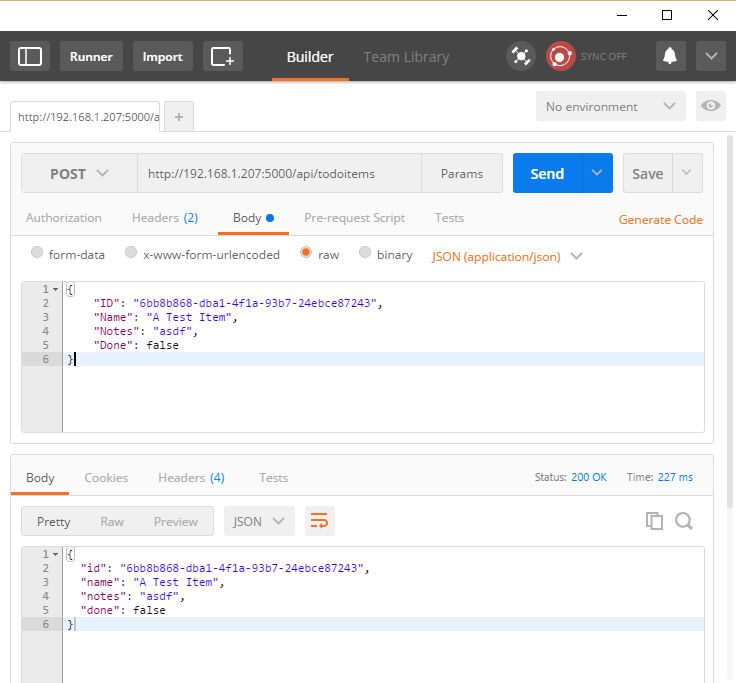
The method returns the newly created item in the response.
Updating Items
Modifying records is done using HTTP PUT requests. Other than this change, the Edit method is almost identical to Create. Note that if the record isn’t found, the Edit action will return a NotFound (404) response.
[!code-csharpMain]
1: using System;
2: using Microsoft.AspNetCore.Http;
3: using Microsoft.AspNetCore.Mvc;
4: using ToDoApi.Interfaces;
5: using ToDoApi.Models;
6:
7: namespace ToDoApi.Controllers
8: {
9: [Route("api/[controller]")]
10: public class ToDoItemsController : Controller
11: {
12: private readonly IToDoRepository _toDoRepository;
13:
14: public ToDoItemsController(IToDoRepository toDoRepository)
15: {
16: _toDoRepository = toDoRepository;
17: }
18:
19: [HttpGet]
20: public IActionResult List()
21: {
22: return Ok(_toDoRepository.All);
23: }
24:
25: [HttpPost]
26: public IActionResult Create([FromBody] ToDoItem item)
27: {
28: try
29: {
30: if (item == null || !ModelState.IsValid)
31: {
32: return BadRequest(ErrorCode.TodoItemNameAndNotesRequired.ToString());
33: }
34: bool itemExists = _toDoRepository.DoesItemExist(item.ID);
35: if (itemExists)
36: {
37: return StatusCode(StatusCodes.Status409Conflict, ErrorCode.TodoItemIDInUse.ToString());
38: }
39: _toDoRepository.Insert(item);
40: }
41: catch (Exception)
42: {
43: return BadRequest(ErrorCode.CouldNotCreateItem.ToString());
44: }
45: return Ok(item);
46: }
47:
48: [HttpPut]
49: public IActionResult Edit([FromBody] ToDoItem item)
50: {
51: try
52: {
53: if (item == null || !ModelState.IsValid)
54: {
55: return BadRequest(ErrorCode.TodoItemNameAndNotesRequired.ToString());
56: }
57: var existingItem = _toDoRepository.Find(item.ID);
58: if (existingItem == null)
59: {
60: return NotFound(ErrorCode.RecordNotFound.ToString());
61: }
62: _toDoRepository.Update(item);
63: }
64: catch (Exception)
65: {
66: return BadRequest(ErrorCode.CouldNotUpdateItem.ToString());
67: }
68: return NoContent();
69: }
70:
71: [HttpDelete("{id}")]
72: public IActionResult Delete(string id)
73: {
74: try
75: {
76: var item = _toDoRepository.Find(id);
77: if (item == null)
78: {
79: return NotFound(ErrorCode.RecordNotFound.ToString());
80: }
81: _toDoRepository.Delete(id);
82: }
83: catch (Exception)
84: {
85: return BadRequest(ErrorCode.CouldNotDeleteItem.ToString());
86: }
87: return NoContent();
88: }
89: }
90:
91: public enum ErrorCode
92: {
93: TodoItemNameAndNotesRequired,
94: TodoItemIDInUse,
95: RecordNotFound,
96: CouldNotCreateItem,
97: CouldNotUpdateItem,
98: CouldNotDeleteItem
99: }
100:
101: }
To test with Postman, change the verb to PUT. Specify the updated object data in the Body of the request.
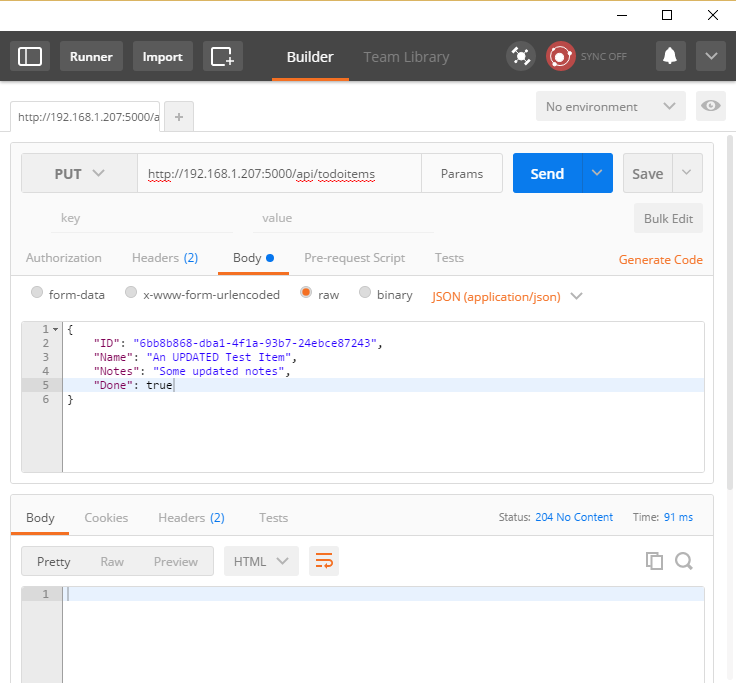
This method returns a NoContent (204) response when successful, for consistency with the pre-existing API.
Deleting Items
Deleting records is accomplished by making DELETE requests to the service, and passing the ID of the item to be deleted. As with updates, requests for items that don’t exist will receive NotFound responses. Otherwise, a successful request will get a NoContent (204) response.
[!code-csharpMain]
1: using System;
2: using Microsoft.AspNetCore.Http;
3: using Microsoft.AspNetCore.Mvc;
4: using ToDoApi.Interfaces;
5: using ToDoApi.Models;
6:
7: namespace ToDoApi.Controllers
8: {
9: [Route("api/[controller]")]
10: public class ToDoItemsController : Controller
11: {
12: private readonly IToDoRepository _toDoRepository;
13:
14: public ToDoItemsController(IToDoRepository toDoRepository)
15: {
16: _toDoRepository = toDoRepository;
17: }
18:
19: [HttpGet]
20: public IActionResult List()
21: {
22: return Ok(_toDoRepository.All);
23: }
24:
25: [HttpPost]
26: public IActionResult Create([FromBody] ToDoItem item)
27: {
28: try
29: {
30: if (item == null || !ModelState.IsValid)
31: {
32: return BadRequest(ErrorCode.TodoItemNameAndNotesRequired.ToString());
33: }
34: bool itemExists = _toDoRepository.DoesItemExist(item.ID);
35: if (itemExists)
36: {
37: return StatusCode(StatusCodes.Status409Conflict, ErrorCode.TodoItemIDInUse.ToString());
38: }
39: _toDoRepository.Insert(item);
40: }
41: catch (Exception)
42: {
43: return BadRequest(ErrorCode.CouldNotCreateItem.ToString());
44: }
45: return Ok(item);
46: }
47:
48: [HttpPut]
49: public IActionResult Edit([FromBody] ToDoItem item)
50: {
51: try
52: {
53: if (item == null || !ModelState.IsValid)
54: {
55: return BadRequest(ErrorCode.TodoItemNameAndNotesRequired.ToString());
56: }
57: var existingItem = _toDoRepository.Find(item.ID);
58: if (existingItem == null)
59: {
60: return NotFound(ErrorCode.RecordNotFound.ToString());
61: }
62: _toDoRepository.Update(item);
63: }
64: catch (Exception)
65: {
66: return BadRequest(ErrorCode.CouldNotUpdateItem.ToString());
67: }
68: return NoContent();
69: }
70:
71: [HttpDelete("{id}")]
72: public IActionResult Delete(string id)
73: {
74: try
75: {
76: var item = _toDoRepository.Find(id);
77: if (item == null)
78: {
79: return NotFound(ErrorCode.RecordNotFound.ToString());
80: }
81: _toDoRepository.Delete(id);
82: }
83: catch (Exception)
84: {
85: return BadRequest(ErrorCode.CouldNotDeleteItem.ToString());
86: }
87: return NoContent();
88: }
89: }
90:
91: public enum ErrorCode
92: {
93: TodoItemNameAndNotesRequired,
94: TodoItemIDInUse,
95: RecordNotFound,
96: CouldNotCreateItem,
97: CouldNotUpdateItem,
98: CouldNotDeleteItem
99: }
100:
101: }
Note that when testing the delete functionality, nothing is required in the Body of the request.
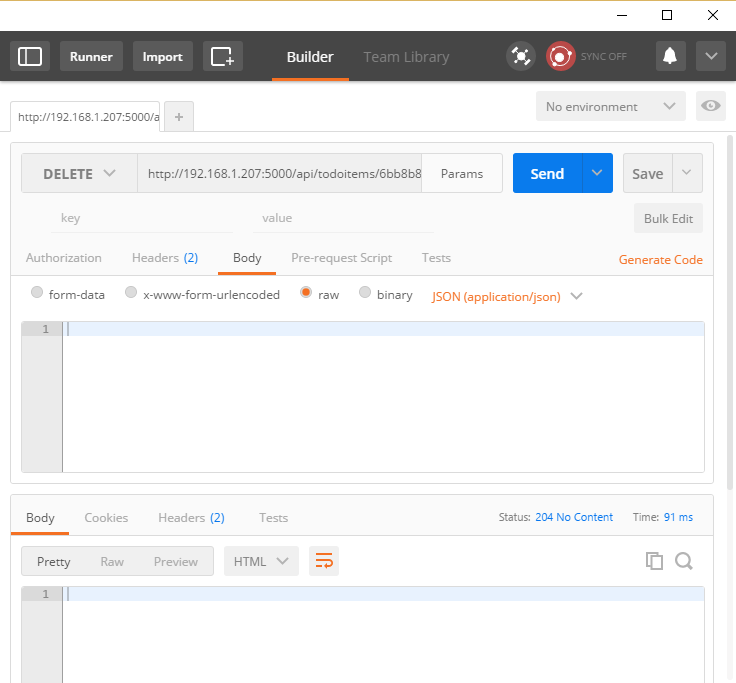
Common Web API Conventions
As you develop the backend services for your app, you will want to come up with a consistent set of conventions or policies for handling cross-cutting concerns. For example, in the service shown above, requests for specific records that weren’t found received a NotFound response, rather than a BadRequest response. Similarly, commands made to this service that passed in model bound types always checked ModelState.IsValid and returned a BadRequest for invalid model types.
Once you’ve identified a common policy for your APIs, you can usually encapsulate it in a filter. Learn more about how to encapsulate common API policies in ASP.NET Core MVC applications.
 )
)
|
|